Last Updated on January 18, 2025 by Sarah Wilson
After an eleven day house-sit in Paris, I hopped on a train and headed south to lovely Lyon. What a gorgeous city. Jonathan and I had planned to visit here in April 2020, but we all know what happened to travel plans that year. We both wanted to visit this city because Lyon is known as the culinary capital of France and we love French food (and Sicilian food, and Slovenian food). In fact, all food! Ah, and I so miss Jonathan’s cooking, but I digress.
Anyway, this city is the perfect base for a three night break and there are plenty of things to do in Lyon to keep you busy. Everything is within walking distance and there is just a charming, laidback feel to the place. One of those cities where you think – ooh I could live here!

So, Here Are My Favourite Things To Do In Lyon
Free walking tour
One thing I love to do whenever I visit a new city is to take a walking tour. It’s such a great way to familiarise yourself with a new place. I always enjoy learning a little about the city I’m exploring, even if I do only manage to retain information for about five minutes. This one I took in Lyon was fun and very informative.
Depending on the day you take this tour, you will be either exploring the Old Town (Vieux Lyon) or a city tour that starts in Presqu’île which covers a wider area. That was the one I was on.
Presqu’île
The name Presqu’île comes from the French words”presque” meaning almost and “île” meaning island. It is located right in the heart of Lyon and extends from the foot of the Croix Rousse hill to where the Rhone and Saône rivers meet. It’s also a great spot to use as your base for exploring Lyon, although many people opt to stay in Vieux Lyon. For me though, this part of Lyon felt more authentic and the perfect spot for experiencing the amazing bouchons – the traditional restaurants of Lyon.
Place des Terreaux
At the heart of Presqu’île is the beautiful 17th century square – Place des Terreaux. This is where the free city walking tour starts from. Here, you’ll find the City Hall that was originally built between 1646 and 1655 but destroyed in a fire in 1674 and later rebuilt in the early 18th century.
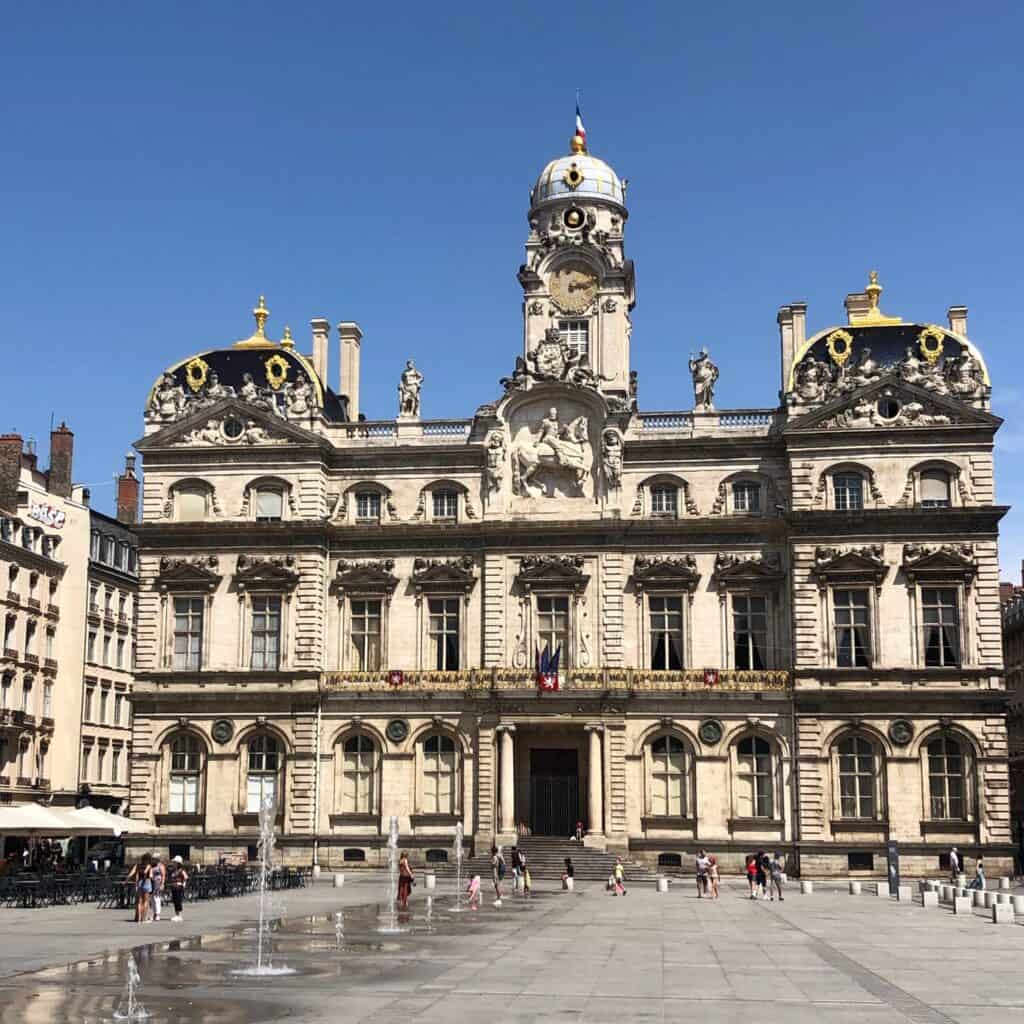
There’s also the Museum of Fine Arts which was closed when I was there but is meant to be very interesting, if that’s your thing. The building was once a royal Benedictine abbey. When it’s open, there’s supposed to be a really lovely shady garden in the back.
And of course, no fancy Italian piazza would be complete without some flashy statue and several bars and cafes.
The square is also a popular spot to visit during the famous Fête des Lumières that takes place in Lyon every December. Sounds amazing, hope to experience this event one day.
Explore The Streets Of Vieux Lyon
Vieux Lyon is a UNESCO world heritage site and Lyon’s largest renaissance site. It is made up of three districts -Saint Jean, Saint Paul and Saint Georges.
The Saint Jean quarter dates back to the Middle Ages and was once the focus of political and religious power. Here you will find the impressive Gothic St Jean Cathedral.
The Saint Paul section began during the 15th and 16th centuries, when Italian banker-merchants began to settle in the area. This part of town looks distinctly more Italian than French.
Lyon, once had a thriving silk industry and during the 16th century, the Saint Georges part of town was where most of the silk weavers could be found, until they later moved up to Croix Rousse during the 19th century.

Do take your time to explore the back streets of Vieux Lyon admire the architecture, enjoy the bars and cafes, and the boutiques.
Discover The Traboules Of Lyon
The traboules of Lyon are a network of passages that run through the city via secret courtyards, through buildings and secluded stairways. Some of these narrow passageways date back to Roman times, but most are from the 19th century when the silk weavers transported their materials across town. The traboules were later used by the Resistance during World War II. Wander the streets of Old Town and Croix Rousse and try and find them or pick up a map from the tourist office for clues.
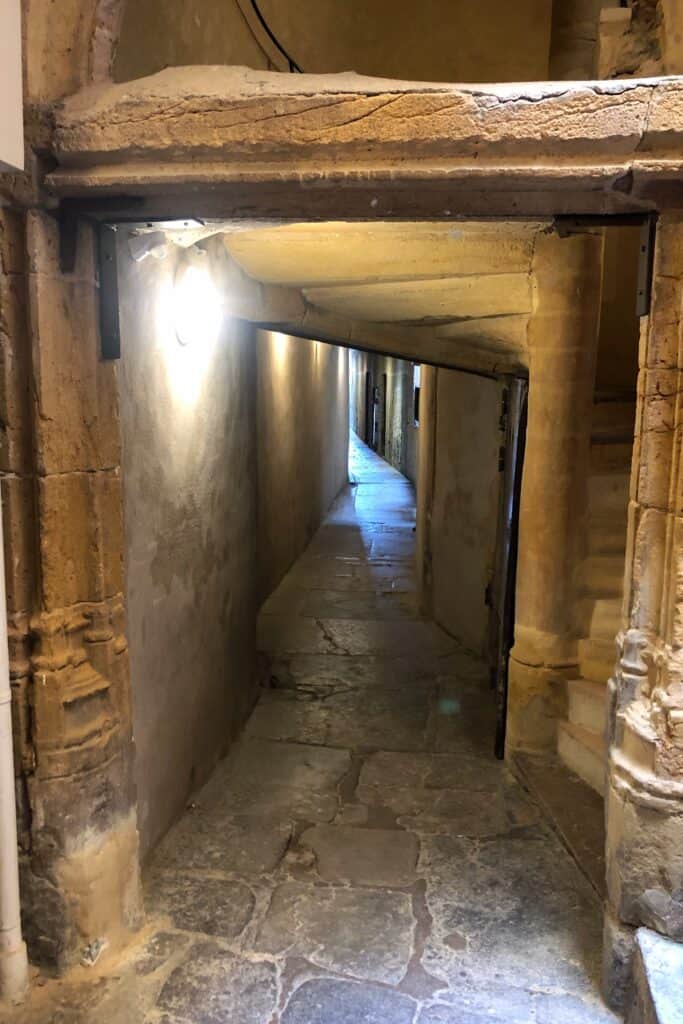
Basilica of Notre-Dame de Fourvière
Walking along side the river from my guesthouse towards Vieux Lyon, it was easy to spot Lyon’s answer to Sacré-Coeur. Located in a commanding position on the Fourvière hill, the Basilica of Notre-Dame de Fourvière offers impressive views over the city.
The Basilica of Notre-Dame de Fourvière was built between 1872 and 1884 on the site of the old Roman forum. The building is referred to as “the upside-down elephant” by locals, because of its large rounded body and four main towers as legs. I guess I can see that, can you? You’ll find some stunning mosaics and stained glass inside the church.
Directly next to the Basilica is a fantastic viewpoint, which offers amazing views over Lyon central. There’s also a cafe/ bar here and when I visited, there was also some live music.
If you don’t fancy the rather steep climb up to Fourvière, there is a funicular that departs from just behind St Jean Cathedral. It also makes a stop at the amphitheatre.
You can return to town the same way but actually it’s a pleasant walk back downhill to town.
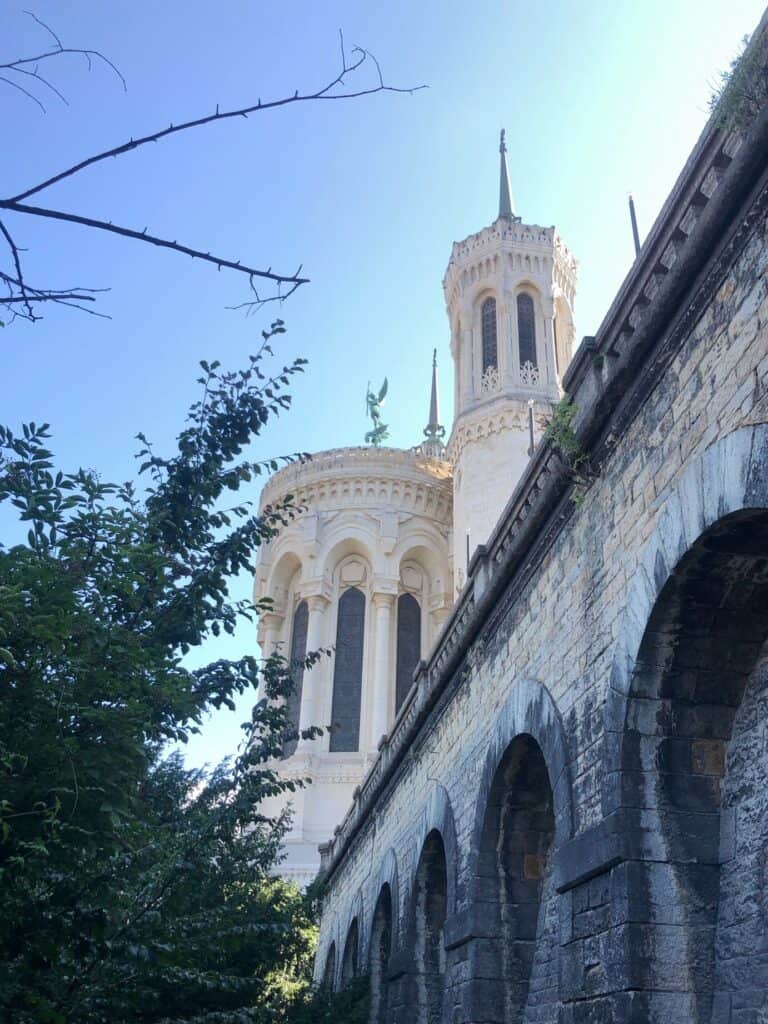
Le Théâtre Antique de Fourviere
A very short walk from the basilica is a Roman amphitheatre, believed to have been built around 2,000 years ago. You can freely wander round the ancient steps and explore this ancient ruin. Every summer, dance, musical, and theatre performances take place here during the Festival Nuits de Fourviere. The festival was on when I was there and I was hoping to attend one of the shows, but the nights I was there, it was just rave music and despite being forever 21, I’m too old for all that now.
Street Art and Murals
Lyon is one of Europe’s most mural-covered cities, second only to Berlin. Probably the most amazing mural you’ll come across is the Fresque des Lyonnais, which features many famous people from Lyon, from Emperor Claudius and going right up to the modern day.

This is probably one of the best murals I have ever seen. It’s close to the Saône river about a five to ten minutes walk from the Place des Terreaux.
Croix Rousse
Since the 19th century, while the Fourvière district with its impressive basilica was known as “the hill that prays”, the Croix-Rousse district has always been known as “the hill that works”.
The Croix-Rousse was once the hub of Lyon’s silk manufacturers. At its peak there were more than 30,000 canuts (the name given to Lyon’s silk workers) and the city was a major hub for textiles in Europe. In fact, to this day, Hermès still continues to produce its legendary silk squares not far from Lyon!
But with just a handful of silk manufacturers left, this district in Lyon is changing with hipster barbers and trendy coffee shops popping up on every corner. It’s still a bit rough round the edges but it has personality.
Visit The Soierie Vivante – Atelier Municipal de Tissage (Silk Weaving Workshop)

As I mentioned, Lyon used to be famous for its silk-weaving industry. It’s possible to visit the last family weaving workshop in Croix-Rousse which allows you a rare chance to see behind the scenes of a silk workshop. It can only be seen on a guided tour but guided tours take place every day from Tuesday to Saturday at 2pm and 4pm.
I turned up on spec and was the only visitor so had a private tour. The guide apologised for her terrible English which was actually absolutely perfect. She was so enthusiastic when she explained all about Lyon’s silk-weaving past and demonstrated how to use the 19th-century handloom, that at the end of the tour, I wanted to be a silk weaver when I grew up.
Tête d’Or Park
I do love my current country base, Malta, but I hate the lack of green space on the island. So now when I travel, I do get weirdly excited by parks. Lyon’s largest and most popular park is the Parc de la Tête d’Or and as parks go, it’s really lovely.

As well as a pleasant place to walk around with its lovely, huge lake, I suddenly found myself in the middle of an African savanna. I did not expect to bump into giraffes in the middle of Lyon. Yes, there’s a large zoo in the middle of the park. Not a fan of zoos, so didn’t go in but nevertheless was very excited to see giraffes, flamingos and hear lemurs.

France’s largest botanical garden is also in this park with more than 20,000 species of plants. Although, at the moment, you could only explore the outdoor gardens, not the greenhouses.
Where To Eat In Lyon?
For Breakfast –
Bored of the typical French breakfast of coffee and croissant with jam? Diplon in Presqu’île near the Place des Terreaux came highly recommended for breakfasts. The staff were lovely, spoke great English, didn’t mock my appalling attempts at French and the prices were reasonable. Pancakes looked absolutely lush, but I had the eggs Benedict which actually were not that great but then again, I am a self confessed eggs Benedict snob.
For A Light Lunch –
Le Banana Creperie in Vieux Lyon also came highly recommended by a friend. I had a fabulous savoury pancake. It’s a great lunchtime spot and a wonderful place to people watch. And then afterwards go next door for ice cream.
For Ice cream –
For ice cream, head to Terre Adelice in the historic Vieux Lyon. It’s located just next door to Le Banana Creperie. This ice cream shop boast around 100 delicious flavours, most are organic, with all the classic flavours and a few weird ones like goat cheese and sea buckthorn.
Fresh Food Markets –
There’s quite a few fresh food markets around the city. I love wandering around local markets. It’s such a great way to discover the vast array of fresh fruit and vegetables, meats, cheeses, spices, wines, bread and more cheeses from the region. And pick up goodies (that would be cheese) to enjoy in the park.
There are large outdoor markets in La Croix Rousse and St Antoine and a very modern indoor market at Les Halles Paul Bocuse.
For Dinner –
You have to try one of les Bouchons Lyonnaise. The Bouchon are the traditional restaurants in Lyon. These restaurants were often founded by les meres and les tante, the mothers and the aunts. Make sure you know exactly what you are ordering, because they do use a lot of cheap cuts like offal and intestines in their dishes.
Really enjoyed dinners at Le Comptoir d’Abel and Bouchon Tupin. No scary cuts served here.
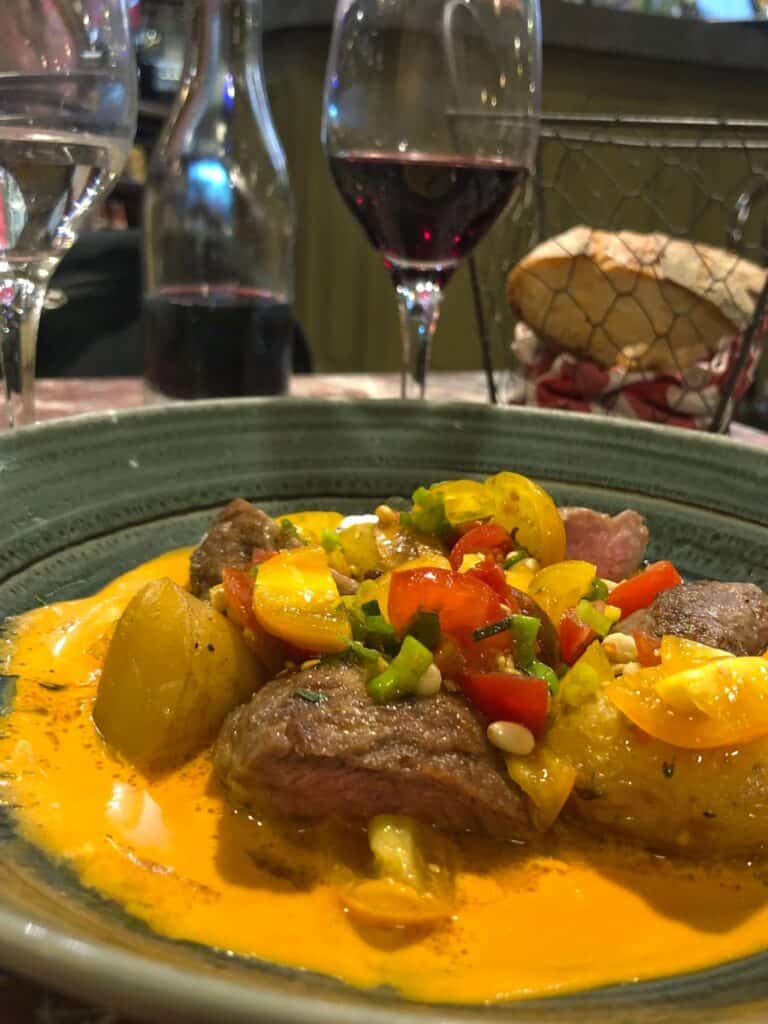
Ran out of time, but friend’s also recommended that I try the Food Traboule. Sadly, didn’t make it there. If you have had the chance to eat here, would love to know about your experience.
How To Get To Lyon
By plane –
The closest airport to Lyon is the Lyons Saint-Exupery Airport which is about 25 kilometres from the city.
To get to Lyon from the airport, the easiest way is to take the very modern and clean Rhone Express. You can book tickets in advance from Lyon Airport to city and vice versa. It’s slightly cheaper if you book in advance and also saves the hassle of queuing for a ticket. The journey time takes around 30 minutes and will take you to the “La Part-Dieu” train station.
Also, there are taxis into town and all the major car rental companies are available at Lyon Airport too. But if you are only planning to visit the city, you won’t need a car, it’s a very walkable city and parking would be an absolute nightmare.
By train –
I took a two hour train journey from Paris Gare de Lyon. I booked the train with OUIGO which sells high speed train journeys at a really low price. Always a good idea to bring snacks and sandwiches for the journey, but if you’re like me and not organised, there are plenty of places to buy sandwiches at the station from Pret A Manger to the more budget conscious Monoprix.
The day I was travelling, the station in Paris was surprisingly busy so do get there early. Boarding starts 30 minutes before train leaves and you do need that time.
By car –
Arrive from Paris by the A6 Highway, or from the South of France by the A7 Highway. Coming from Geneva or Chambéry, take the A43 Highway. For information on renting a car, take a look here.
But with just three days in this city, I’m sure I barely scratched the surface. There are so many wonderful things to do in Lyon. Loved this French city. What’s your favourite city in France?
For More Posts On France, Check These Out
- Cruising the Canal du Midi
- Beautiful Mont Saint Michel Photos
- A Feast of Oysters in Cancale, France
- A Visit To Bayonne
- A Day Trip to Giverney from Paris
- Explore Paris Like A Local With Paris Greeters
- Visiting The Paris Catacombs
- Pere La Chaise Cemetery
- A Secret Food Tour In Paris
- Easy Day Trips By Train From Tours Around The Loire Valley
- An Afternoon In Angouleme
- Best things to do in Beziers
- The Incredible Frescoes of Beziers
- A Luxury Barge Cruise On The Burgundy Canal
- Best Things To Do In Bordeaux
- Saint Emilion: Day Trip From Bordeaux or Stay Overnight?
- One Day in Narbonne
Pin This For Later
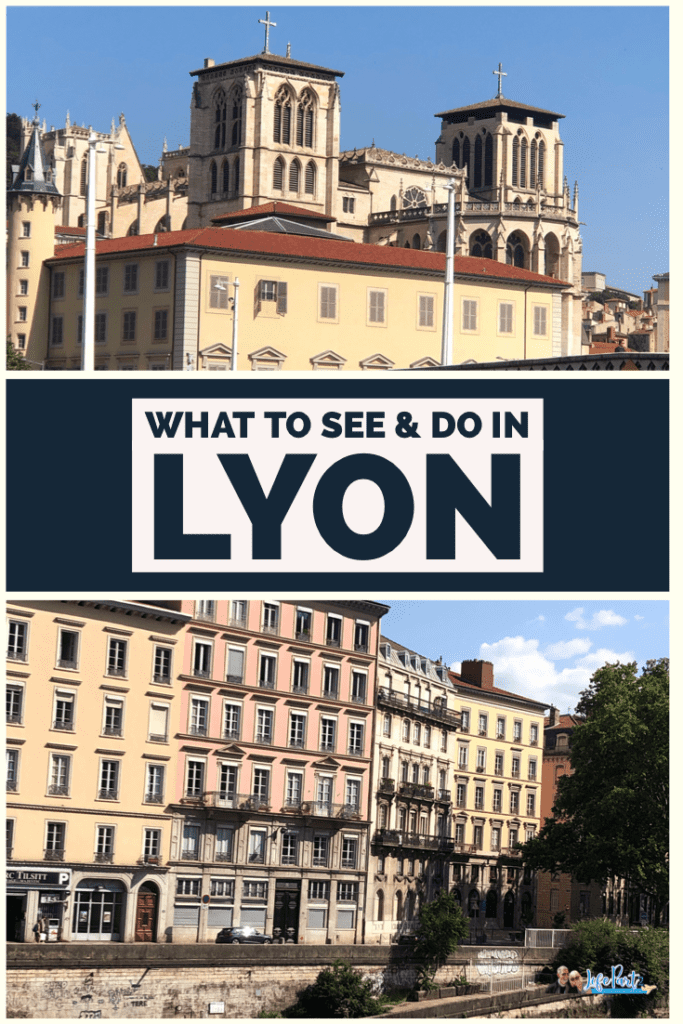




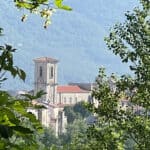

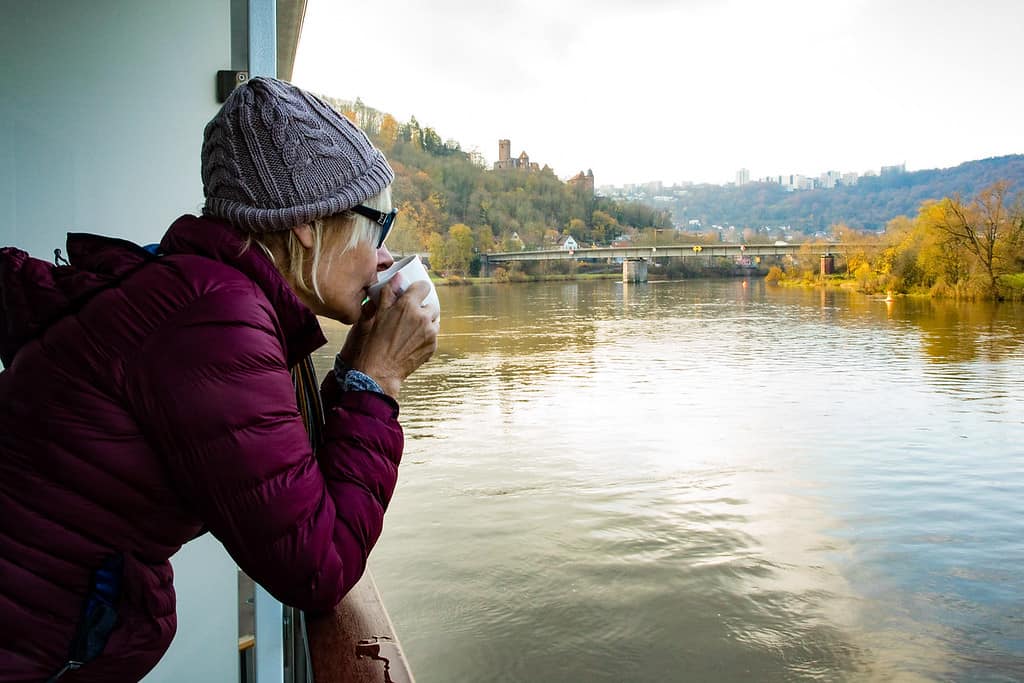
A lovely round-up of the delights to be found in Lyon. I particularly like the street art on display there. I haven’t been before but it looks like a place I would enjoy wandering around.
I love the sound of Lyon & have never been. I’m with you on the joys of a walking tour & they can be fantastic to get your bearings when you visit any cities. The traboules also sound fascinating. I will be adding Lyon to my list & definitely come back for a read when I’m booked.
I also always love to start with a walking tour to get a feel for the geography and vibe of the city. I love ice cream and am always searching for the best so would stop where you recommended.
Sounds like the Vieux Lyon just needs a Ringo section to be called the “zone de Coléoptères à Lyon”…”the Beatles area of Lyon”…cause it already has a Jean, Paul, and George section…..hello is this thing on??
Haha, but seriously, sounds like there are tons of Free and amazing things to do in Lyon. I love just walking around the old town parts of a city so the traboules would be neat and exploring all the street art would be cool. Never would have thought Lyon would be such an epic place for Murals.
Lol, never thought of that.
Lovely post on a city that is frequently overlooked. It is the ideal walking city with a cuisine to die for. Great that you give tips on getting there, something frequently missing in other posts.
Does the free walking tour include stops to see murals? I would love to do a mural tour and see all the different art pieces!
Yes, it does. And the guide also gave information where to find some of the other murals that weren’t so close to the centre.
I didn’t know that Lyon was the culinary capital of France. I want to visit France just for the food! I also had no idea it was known for all their murals. Cities with murals are so fun. Is there a ton of bakeries in Lyon? I want a fresh baguette!
Oui, there are a ton of bakeries in Lyon 🙂
Self planned walking tours are always a part of my itinerary in any city I tour. Good you planned one for Lyon. Architecture there is really interesting. Loved the art and- mural work- too.
We are sorry that we have not yet visited Lyon. If for nothing else than all the great food we have heard about. I can see we would do a lot of walking that would fuel our appetite. And enjoy some relaxing time in the botanical gardens too. Definitely on the “to visit” list.
Being French obsessed, and a bit of a foodie, Lyon has long been on my list of places to visit. I love the journey you took me on through your article, and now need to make sure I include the traboules of Lyon. Such a fascinating history they have.
Love Lyon ,was there few years ago with the kids. I love taking pictures of the architecture.